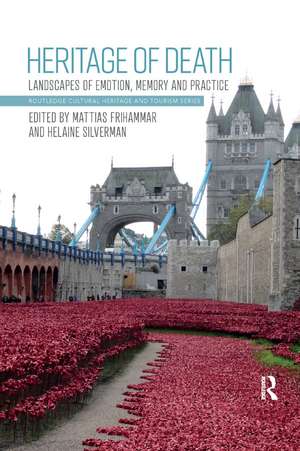Heritage of Death: Landscapes of Emotion, Memory and Practice: Routledge Cultural Heritage and Tourism Series
Editat de Mattias Frihammar, Helaine Silvermanen Limba Engleză Paperback – 12 dec 2019
| Toate formatele și edițiile | Preț | Express |
|---|---|---|
| Paperback (1) | 273.24 lei 6-8 săpt. | |
| Taylor & Francis – 12 dec 2019 | 273.24 lei 6-8 săpt. | |
| Hardback (1) | 765.43 lei 6-8 săpt. | |
| Taylor & Francis – 30 noi 2017 | 765.43 lei 6-8 săpt. |
Din seria Routledge Cultural Heritage and Tourism Series
-
 Preț: 325.68 lei
Preț: 325.68 lei -
 Preț: 311.41 lei
Preț: 311.41 lei -
 Preț: 285.79 lei
Preț: 285.79 lei -
 Preț: 281.57 lei
Preț: 281.57 lei -
 Preț: 316.51 lei
Preț: 316.51 lei -
 Preț: 364.17 lei
Preț: 364.17 lei - 16%
 Preț: 274.06 lei
Preț: 274.06 lei -
 Preț: 387.38 lei
Preț: 387.38 lei -
 Preț: 382.47 lei
Preț: 382.47 lei -
 Preț: 386.18 lei
Preț: 386.18 lei -
 Preț: 386.22 lei
Preț: 386.22 lei -
 Preț: 152.11 lei
Preț: 152.11 lei -
 Preț: 389.11 lei
Preț: 389.11 lei - 18%
 Preț: 1003.75 lei
Preț: 1003.75 lei - 20%
 Preț: 259.98 lei
Preț: 259.98 lei - 18%
 Preț: 1001.07 lei
Preț: 1001.07 lei - 18%
 Preț: 1000.30 lei
Preț: 1000.30 lei
Preț: 273.24 lei
Preț vechi: 326.89 lei
-16% Nou
Puncte Express: 410
Preț estimativ în valută:
52.28€ • 54.78$ • 43.22£
52.28€ • 54.78$ • 43.22£
Carte tipărită la comandă
Livrare economică 11-25 aprilie
Preluare comenzi: 021 569.72.76
Specificații
ISBN-13: 9780367884154
ISBN-10: 0367884151
Pagini: 262
Dimensiuni: 156 x 234 x 22 mm
Greutate: 0.49 kg
Ediția:1
Editura: Taylor & Francis
Colecția Routledge
Seria Routledge Cultural Heritage and Tourism Series
Locul publicării:Oxford, United Kingdom
ISBN-10: 0367884151
Pagini: 262
Dimensiuni: 156 x 234 x 22 mm
Greutate: 0.49 kg
Ediția:1
Editura: Taylor & Francis
Colecția Routledge
Seria Routledge Cultural Heritage and Tourism Series
Locul publicării:Oxford, United Kingdom
Public țintă
Postgraduate and UndergraduateCuprins
PART I Introduction
1. Heritage of Death: Emotion, Memory and Practice MATTIAS FRIHAMMAR AND HELAINE SILVERMAN
PART II Affect
2. Graveside Shrines: Private or Public Space? EVA SILVÉN 3. Framing Children’s Sections in Cemeteries CATHARINA NOLIN 4. Taken "As Read": Locating Death in the Rhetoric of Cemetery Conservation in England JULIE RUGG
PART III Celebrity
5. "At last, Garbo is coming home": Celebrity, Death and Nation MATTIAS FRIHAMMAR 6. Dissonant Heritage and Dark Tourism at Lenin’s Mausoleum MAGDALENA BANASZKIEWICZ 7. The Corpse, Heritage, and Tourism: The Multiple Ontologies of the Body of King Richard III of England CRAIG YOUNG AND DUNCAN LIGHT
PART IV War
8. The Poppies Exhibit: Producing and Consuming Commemoration of World War I in Britain PAUL HARDIN KAPP AND CELE C. OTNES 9. At the Shrine of the Fallen: Conserving Australia’s War Memorial Heritage DAVID MASON 10. "Now you have visited the war": The Search for Fallen Soldiers in Russia JOHANNA DAHLIN
PART V Oppression
11. Armenia Aeterna: Commemorative Heritage in Sound, Sculpture, and Movement from Bulgaria’s Armenian Diaspora DONNA A. BUCHANAN 12. Uncovering Violent Narratives: The Heritage of Stalinist Repression in Russia since 1991 MARGARET COMER 13. The Peculiar Heritage of Lynching in America RASUL A. MOWATT
PART VI Unbounded
14. Death Everywhere: Dissolving Commemorative Boundaries in a Liquid World DAVID CHARLES SLOANE 15. Tourists at Chernobyl: Existential Meaning and Digital Media TIM HUTCHINGS AND KATYA LINDEN
PART VII Epilogue
16. "Dark" Tourism and the Heritage of Death JOY M. SATHER-WAGSTAFF
1. Heritage of Death: Emotion, Memory and Practice MATTIAS FRIHAMMAR AND HELAINE SILVERMAN
PART II Affect
2. Graveside Shrines: Private or Public Space? EVA SILVÉN 3. Framing Children’s Sections in Cemeteries CATHARINA NOLIN 4. Taken "As Read": Locating Death in the Rhetoric of Cemetery Conservation in England JULIE RUGG
PART III Celebrity
5. "At last, Garbo is coming home": Celebrity, Death and Nation MATTIAS FRIHAMMAR 6. Dissonant Heritage and Dark Tourism at Lenin’s Mausoleum MAGDALENA BANASZKIEWICZ 7. The Corpse, Heritage, and Tourism: The Multiple Ontologies of the Body of King Richard III of England CRAIG YOUNG AND DUNCAN LIGHT
PART IV War
8. The Poppies Exhibit: Producing and Consuming Commemoration of World War I in Britain PAUL HARDIN KAPP AND CELE C. OTNES 9. At the Shrine of the Fallen: Conserving Australia’s War Memorial Heritage DAVID MASON 10. "Now you have visited the war": The Search for Fallen Soldiers in Russia JOHANNA DAHLIN
PART V Oppression
11. Armenia Aeterna: Commemorative Heritage in Sound, Sculpture, and Movement from Bulgaria’s Armenian Diaspora DONNA A. BUCHANAN 12. Uncovering Violent Narratives: The Heritage of Stalinist Repression in Russia since 1991 MARGARET COMER 13. The Peculiar Heritage of Lynching in America RASUL A. MOWATT
PART VI Unbounded
14. Death Everywhere: Dissolving Commemorative Boundaries in a Liquid World DAVID CHARLES SLOANE 15. Tourists at Chernobyl: Existential Meaning and Digital Media TIM HUTCHINGS AND KATYA LINDEN
PART VII Epilogue
16. "Dark" Tourism and the Heritage of Death JOY M. SATHER-WAGSTAFF
Notă biografică
Mattias Frihammar is a teacher and researcher in the Department of Ethnology at Stockholm University (SU). He is the founder of the Critical Heritage Studies Network and a member of the Scientific Council for the Master’s Programme in Cultural Heritage Management at SU.
Helaine Silverman is Professor in the Department of Anthropology at the University of Illinois and Director of the Collaborative for Cultural Heritage Management and Policy (CHAMP).
Helaine Silverman is Professor in the Department of Anthropology at the University of Illinois and Director of the Collaborative for Cultural Heritage Management and Policy (CHAMP).
Descriere
Today, death is being reconceptualised around the world as heritage, replete with material markers and intangible performances. This book brings together more than twenty international scholars to consider the heritage of death from spatial, political, religious, economic, cultural, aesthetic and emotive aspects. It showcases different attitudes
